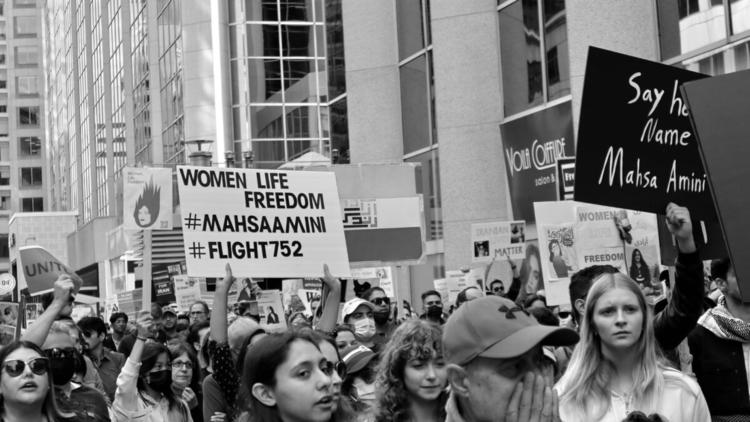A year after Mahsa Amini’s death, Iran intensifies surveillance on women
This piece was first published by Alliance for Universal Digital Rights (AUDRi), on September 16, 2023, and was written by Emma Gibson, the global coordinator for AUDRi. An edited version is republished here with permission
( Globalvoices.org ) – September 16, 2023, marked a year since the death of 22-year-old Mahsa Amini following her arrest by the Iranian government’s “morality” police. In the week leading up to the anniversary, human rights organizations Equality Now, Femena, and Centre for Supporters of Human Rights (CSHR), made a joint submission to the UN Human Rights Committee expressing “deep concerns about the condition of women and girls in Iran regarding the continued prevalence of female genital mutilation (FGM), child marriage, and sex-discriminatory personal status laws in the country.”
In recent years, protests against the mandatory hijab or the so-called “morality police” in Iran have made international headlines. The bravery of women, often leading the charge, cannot be overstated. However, these protests are often met with severe consequences, increasingly driven by the government’s sophisticated digital surveillance apparatus.
A controversial new hijab bill includes 70 articles that prescribe harsher penalties for women, as well as severe sanctions against public figures, businesses, and service providers who support them. The bill proposes the use of artificial intelligence (AI) to enforce dress code violations, reflecting a disturbing manifestation of gender-based persecution.
In today’s digital age, Iran’s government has been wielding a two-edged sword: the same technology that has the potential to empower voices is being used to silence them, especially when those voices call for gender equality. Using advanced facial recognition software and tracking online interactions, the government identifies and harasses those who dare to dissent.
This technological might is disproportionately used against women, whose demands for equal rights are seen as direct threats to the state’s ideological foundation.
It’s not just about cameras on street corners or drones in the sky. The real Orwellian nightmare lies in the shadows of the internet. Popular platforms are censored, and encrypted messaging apps, on which protesters often rely to organize, are blocked. Bloggers, influencers, and even ordinary citizens face intimidation, arrest, or worse for simply expressing their opinions online.
Iran Protests,’ Ottawa, Canada, September 25, 2022, by Taymaz Valley on Flickr (CC BY 2.0.).
Perhaps most disturbing is the state’s increasingly invasive eye into private spaces: the cars and walking routes of private citizens.
A chilling testament to this is the fact that, within a mere span of three months, almost a million women were texted warnings from the nation’s police force. Their crime? Being captured by ever-watchful cameras without a hijab, as detailed by a harrowing report from Amnesty International.
According to the report, the police “issued 133,174 SMS messages requiring the immobilization of vehicles for a specific duration, confiscated 2,000 cars, and referred more than 4,000 ‘repeat offenders’ to the judiciary across the country.”
From Iran to the world: An international call to action
Digital rights are, at their core, human rights. A society where individuals cannot communicate freely, privately, and securely is one where fundamental freedoms are under assault.
Digital rights exist alongside the right to peaceful protests in multiple ways. Encrypted communication tools can offer activists and protesters a way to communicate without the fear of government interception or retribution. When mainstream media is censored or muzzled, social media platforms can allow for the rapid dissemination of information, rallying supporters for a cause. Furthermore, the digital realm offers an expansive library of resources on peaceful protest tactics, rights awareness, and international solidarity efforts.
Iran is far from being the only regime restricting digital freedoms while using technology to suppress dissent or co-opting its surveillance. In India, for example, police have made use of an app which allows them to access privately-gathered CCTV footage.
In China, mass surveillance has been used to gather information about the movements and activities of private individuals in a form of “predictive policing.” Across all these examples, there is evidence that surveillance and infringement on privacy rights disproportionately target individuals and groups whose identities make them vulnerable, such as women or minorities, or whose political activities challenge the status quo.
But here lies the challenge: As governments like these become more adept at quelling online dissent, how can activists stay a step ahead?
The international community can play a crucial role. Tech companies must be pressured to safeguard user data and prioritize end-to-end encryption. Digital rights organizations and civil society should be consulted on the threats posed by state-led digital surveillance and censorship and the implications of the technology being produced.
Most importantly, the global community should consistently spotlight abuses, ensuring governments understand that the world is watching. And regulation of the digital space along human rights principles will ensure that this does not become a new environment in which Iranian women, or any others, are vulnerable to abuse and harm.
While the Iranian government’s tactics are emblematic of a more significant global issue, the world must remember and uplift the unique bravery of Iran’s women, who stand tall even when shadows loom large. For Mahsa Amini and countless others like her, we must persist in our shared fight for digital and human rights. Their courage deserves nothing less.






 © 2025 All Rights Reserved
© 2025 All Rights Reserved